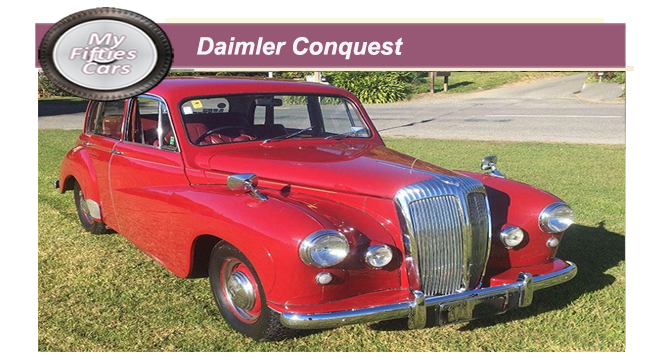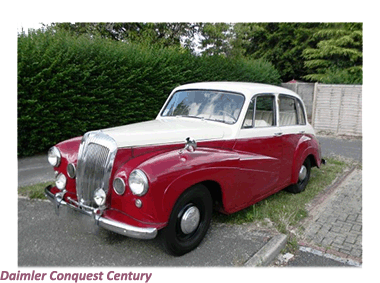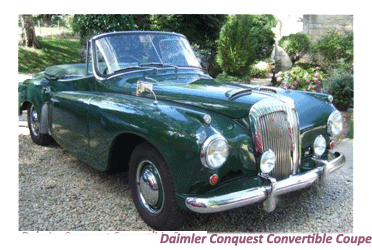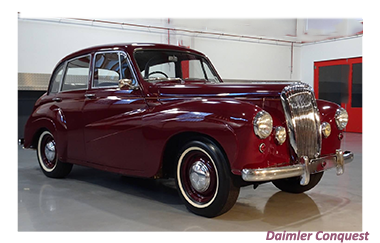
The Daimler Conquest, released in 1953 was one of the company’s most substantial investments in the early Fifties, with its lack of commercial success playing a significant part in weakening the Daimler’s finances during much of the Fifties.
 Once again, the style of the Conquest bore a strong resemblance to another Daimler model, this time the Regency, although the cars shared no common engineering or panels, as the body was produced as a single entity from the Pressed Steel Company.
Once again, the style of the Conquest bore a strong resemblance to another Daimler model, this time the Regency, although the cars shared no common engineering or panels, as the body was produced as a single entity from the Pressed Steel Company.
 Although the Conquest was a direct replacement for the Consort, there were no carryover parts, as the Conquest was built on a shorter-wheelbase cruciform-based chassis frame.
Although the Conquest was a direct replacement for the Consort, there were no carryover parts, as the Conquest was built on a shorter-wheelbase cruciform-based chassis frame.
The Conquest's chassis and body evolved from the export version of the Lanchester Leda/LJ201 model, which had been on the market since 1950-51.
Much of the running gear had the traditional flavour — including the usual fluid flywheel/pre-selector transmission and Girling hydro-mechanical braking.
 Inside the car, there was the customary Daimler combination of polished wood, leather seating and fine carpets. Characteristically for a Daimler„ the Conquest also had quite a lofty, airy cabin with plenty of headroom and only a minimal transmission tunnel hump.
Inside the car, there was the customary Daimler combination of polished wood, leather seating and fine carpets. Characteristically for a Daimler„ the Conquest also had quite a lofty, airy cabin with plenty of headroom and only a minimal transmission tunnel hump.
The advantages that the Daimler Conquest provided in comfort and road holding, it took away in terms of speed, with its 2.4-litre engine with an iron head and single Zenith carburettor generating just 75bhp.
Once Daimler introduced the more powerful Century the following year, sales of the original Conquest was speedily overshadowed.
The writing was on the wall, and despite some fairly aggressive marketing and a significant price reduction, the basic Conquest was discontinued in 1956.
![]()
Although still bearing something of a resemblance to a traditional Daimler, the Conquest Century came with its headlights mounted on the wings, which had also undergone something of a design makeover, signalling at least a desire for some progression.
 The Daimler Conquest Century came with a new six-cylinder engine rated at 56kW (75bhp), while its independent front suspension used laminated torsion bars, unlike the other Daimler models of that time, which used coil springs.
The Daimler Conquest Century came with a new six-cylinder engine rated at 56kW (75bhp), while its independent front suspension used laminated torsion bars, unlike the other Daimler models of that time, which used coil springs.
 As far as trim was concerned, the Conquest and Conquest Century were still traditional Daimler with plenty of wood and leather.
As far as trim was concerned, the Conquest and Conquest Century were still traditional Daimler with plenty of wood and leather.
As was their practice, Daimler squeezed yet another model out of the Conquest range, this time a Conquest Century roadster, the first sports car released by the company since 1908.
The Conquest was fitted with an alloy-body, with its principal design features a wraparound windscreen, cutaway doors and tail fins; the Conquest Century roadster was soon joined by a coach built two-door Drophead body version, produced for Daimler by Carbodies.
 The Century roadster enjoyed considerably less commercial success than its soft topped sister.
The Century roadster enjoyed considerably less commercial success than its soft topped sister.
Production was abandoned in mid-1955 after just 234 models had been sold,
![]()
In 1954 Daimler, following on the success of their more compact and sleek designed Consort, began to place a design emphasis on modern lightweight cars in a drive to move away from the traditional staid image they had become known for in the immediate post-war years.
 Within a year of the original Conquest going on sale, Daimler once again tweaked their model range, with the introduction of the Conquest Century variation.
Within a year of the original Conquest going on sale, Daimler once again tweaked their model range, with the introduction of the Conquest Century variation.
According to Daimler, the "Century" part referring to the power output of the 2.4-litre engine, which had been pushed up from 75bhp to 100bhp with the help of a light-alloy cylinder head, twin SU carburettors, larger valves and a different camshaft profile.
 Despite boosting the car’s engine’s power by one-third boost in power, the rest of the engineering of the Conquest remained mostly unchanged, with only minor changes, such as the car’s brakes being enlarged.
Despite boosting the car’s engine’s power by one-third boost in power, the rest of the engineering of the Conquest remained mostly unchanged, with only minor changes, such as the car’s brakes being enlarged.
Cosmetically a rev-counter was added to the fascia display, while an extra four inches of rear seat space were created by moving the seats backwards, an upgrade that was also made to later examples of the Conquest saloon.
The Conquest series remained in production till 1956.


